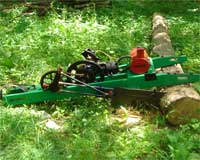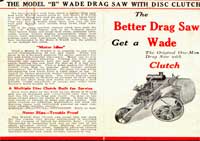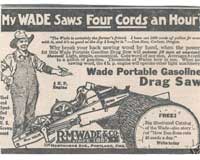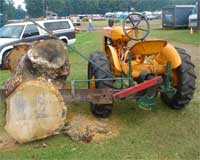W
e e k l y F
e a t u r e P a g e
Links to archived past pages on lower left
| The contents of the “Weekly Feature” page are provided
to you for your entertainment, amusement, and perhaps information.
Here you may find articles of interest, pictures, historical information
on the Club, or whatever shuffles to the top of the pile on our
desk. The only defined characteristic of this space is that we
will make every effort to change/replace it around the middle of
each week. Thank you for visiting, and please stop by again. Click
on any photo to see it larger in a separate window. |
GRANDAD'S
TREE CLIMBER
By
Myrle Gorsline
Click on most images to enlarge 
As a boy I remember asking grandad about a pile of
metal parts and rotting wood sinking into the ground behind his old
barn. He called it a “tree climber” and told me it had
been used for cutting wood and logging. It hadn’t been used for
a long time and I really didn't understand what it was supposed to
look like and much less how it was meant to function.
For 50 some years I periodically thought about the
old machine before finally doing something with it. Grandad’s
old farm in Oregon still belongs to my family so didn't have to spend
a lot of time convincing
someone to let me do some treasure digging. The climate there (unlike
Michigan) is pretty forgiving to things left out in the elements for
decades and I was hopeful of retrieving a restorable piece of mechanical
history
Removed it from the ground without the foresight
of taking any pictures, but by that time the only thing showing was
a couple of inches of a
rounded piece of metal that turned out to be the flywheel. With some
careful shovel time the engine block attached to the flywheel and a
pile of miscellaneous brackets, bolts and other mysteries had been
unearthed. All that remained of the wooden frame were a few pieces
of crumbly rotten fibers you could squash with your fingers. Spent
another hour or so sifting through the dirt looking for anything else
that remotely looked like it might have belonged to the “tree
climber” and ended up with a few dozen pieces of dirty, rusty
metal and old bolts. During the restoration process I learned that
fortunately all of the original tree climber parts had been found along
with several extraneous pieces whose origin will likely remain a mystery
forever. And grandad or someone else had thoughtfully hung the crosscut
type saw blade in the still standing old barn so it was in great shape.
The motor block had RM WADE cast into it and the
model and serial number on an undamaged brass tag were still visible.
Strange looking motor
turned out to be a water cooled 2 cycle with block and head cast as
one piece.
After hauling the pile of parts (along with a couple
other projects) back to Michigan the real work part started. Moving
parts were predictably
seized up by a combination of rock hard grease, surface rust and old
age arthritis. The normal countless old iron hours were spent chipping
away the petrified grease and freeing up sliding and rotating things
so they could be disassembled, cleaned, repaired, painted and reassembled.
The normal drudgery of restoring an old piece of equipment, but it
was actually progressing pretty well. Started to think this was going
to be a piece of cake until the infallible law of projects reared it’s
ugly head to remind me that no project ever goes as well as expected
and always takes more time, effort and probably money than you had
planned.
Had arrived at the point of trying to remove the piston. Bottom of
which is reasonably accessible with crankcase cover and crank removed,
but since the block and head are cast as one piece the only access
to the top is through the spark plug hole which doesn’t help
much. As expected the piston was frozen solidly in place, but really
more like welded in place. And it seemed that it planned on staying
that way through forever. For weeks that turned into months I soaked
it with every kind of penetrating fluid that could be found (WD40,
JB80, Kroils, PB Blaster, Rustlick, kerosine, soapy water, some combinations
of things suggested to me and some I made up) but nothing worked. Heated
the block as much as possible without turning it to a liquid state,
tapped on bottom of piston (being careful not to damage anything),
fabricated a slide hammer attachment which was bolted to connecting
rod and tried to impact it loose. Nothing! Not a fraction of a hair
of movement. Pressurized the cylinder bore through the spark plug hole
with compressed air, tapped, heated, pulled, impacted, soaked, and
swore. Nothing!
Close to giving up and accepting that the old piston
was going to have to be destroyed to get it out, the search for advice
was expanded.
Advice (as normal) was cheap, plentiful, largely irrelevant and most
of the sincere suggestions had already been tried. Then the machinist
at local auto parts store said he had heard of packing the inside of
pistons with dry ice to loosen them. Hadn’t tried this yet! Grabbed
a cooler, headed for Meijer and was back before long with several pounds
of the weird cold steamy stuff. Packed bottom of piston full, waited
a few minutes and started tapping. It moved! Just a few thousanths
of an inch, but it moved. And then it was only a matter of getting
it to move a little farther every time you tapped it in or slide hammered
it out. Several hours of back and forth persuading before it came totally
free, but it finally did and was time for a beer (actually several)!!
Amazingly piston, cylinder bore and even the rings were in decent shape
after some cleaning. The piston pin was only part in the entire saw
corroded beyond use but that was a simple to solve problem. The internet
is great. Hard to believe the human race actually survived and prospered
for so long without it. A racing parts supplier in California had a
pin with exact same dimensions on the shelf which was about $12 delivered.
Ground the crankshaft, machined some fixtures and
re-poured the babbit bearings that were in sad shape. Had the water
jacket boiled out and
fixed a freeze crack. Reassembled the motor, repaired some leaks in
the water and gas tanks, rebuilt and recharged the magneto, and started
working on the wood frame.
RM Wade who manufactured the saw in Portland Oregon is still in business,
but now distributes lawn equipment. So I contacted them requesting
any information and advice they might be able to supply. Susan Russell
(the big boss’s assistant, company history buff and a very helpful
lady) mailed me a large envelope with copies of old advertisements,
sales brochures, parts lists and some general history and dates on
the various saws they had manufactured. A lot of documents had been
destroyed when the manufacturing plant burnt down years ago including
detailed serial number records so impossible to exactly date the saw.
RM Wade starting building drag saws in 1919 and the model number of
grandad’s tree climber was built from 1934 until production was
discontinued which was apparently due to the fire. There was a parts
list dated 1941 in the package from Susan so I assume that at least
parts were available until then. No color pictures in the collection,
but she said the wood frame was supposed to be dark forest green, the
metal parts black and the tanks bright red.

From the information supplied by Susan, pictures found
on line, and mounting holes in the metal parts it was not real difficult
to reconstruct the wooden wheelbarrow kind of frame. Painted all of
the parts and the frame, bolted everything together and was ready for
the big test.
Wheeled the old (new looking) tree climber outside,
poured some chain saw gas in the fuel tank, spun the flywheel a few
times and it noisily
smoked to life and ran probably as good as it ever did. Started better
that first time than it ever has since.
Flywheel starting turned out to be a bloody knuckle
torture routine. Never learned how to spin it without scrapping my
knuckles on the drive
chain and even then getting it to start was not a sure thing. After
the first year I made a starting crank that has saved a lot of band
aids and makes starting quickly a much higher probability. For a few
years I thought the crank had totally solved the problem. Then at the
MMOGTA show last year the engine backfired and crank slapped me on
upper arm leaving a painful purple hardball size bruise that took several
weeks to completely disappear. Another painful lesson learned from
the tree climber.
The tree climber will never be serious competition
for a modern chain saw, but was certainly a huge step forward from
a human powered cross
cut. The advertisements claimed it was also usable for powering other “small
light machinery” by disengaging the saw clutch and using a pulley
or driveshaft attached to the engine crankshaft.
Have never figured out why grandad called the old
drag saw a “tree
climber”. Motor vibrates, but saw doesn’t jump around much
when it’s actually cutting. Maybe he had a bad experience with
it. Sure wish I had asked him!

There were many other companies that manufactured
powered drag saws of various configurations.
|
|
DRAG SAWS AT 2011 MMOGTA SHOW |
PTO POWERED DRAG SAW |
|










